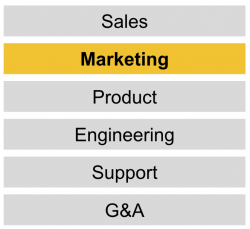This is article #11 out of 50 in The Startup Marketing Playbook.

Over the last 10-15 years, marketing has become far more measurable and analytical. Using closed loop reporting and marketing automation systems, marketers can quickly zoom in on key metrics that indicate whether they are executing effectively. Here is a breakdown of 9 metrics to consider tracking:
MQLs by source
The key funnel metric that you (and your VP of Sales) will care about is marketing qualified leads (MQLs). As a reminder, MQLs are leads that “raise their hand,” indicating they are ready to talk to sales by filling out a demo request form on your website. The more MQLs you can feed to your sales team, the more swings at bat they have to start a conversation. Additionally, you can segment MQLs by source (e.g how many leads came from your email marketing campaigns versus your paid online ads) This can all be tracked by the marketing automation system.

 This is article #5 out of 50 in
This is article #5 out of 50 in  This is article #2 out of 50 in
This is article #2 out of 50 in